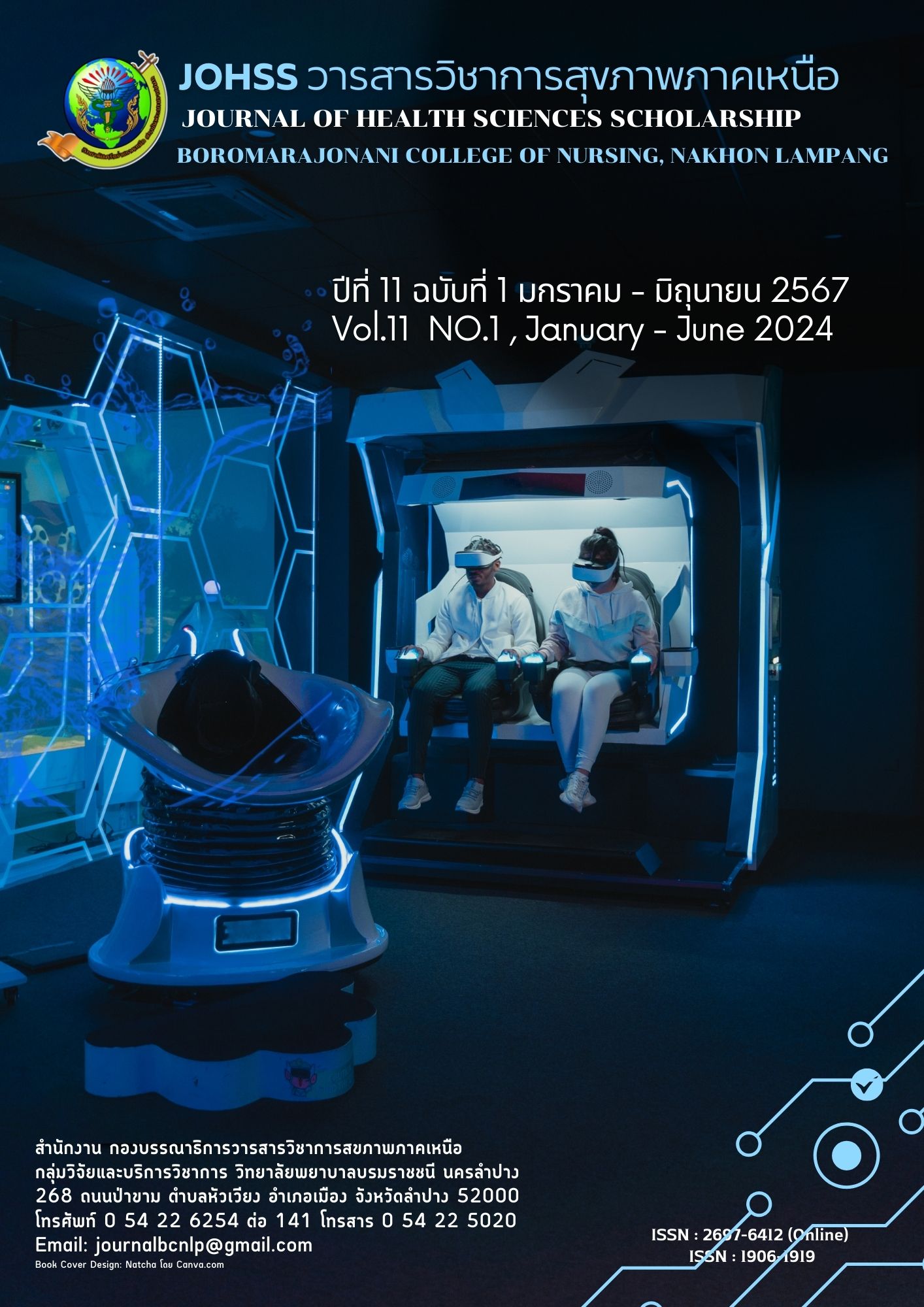ผลของการใช้โปรแกรมสร้างเสริมความรอบรู้ด้านสุขภาพในการดูแลตนเอง ของผู้ป่วยวัณโรคระยะเข้มข้น
บทคัดย่อ
การวิจัยกึ่งทดลองครั้งนี้ มีวัตถุประสงค์เพื่อศึกษาผลของการใช้โปรแกรมสร้างเสริมความรอบรู้ด้านสุขภาพในการดูแลตนเองของผู้ป่วยวัณโรคในระยะเข้มข้นโดยเปรียบเทียบระดับความรอบรู้ด้านสุขภาพ ความรู้เกี่ยวกับวัณโรค และ พฤติกรรมการดูแลตนเองของผู้ป่วยวัณโรคก่อนและหลังการทดลอง กลุ่มตัวอย่างคือ ผู้ป่วยวัณโรค จำนวน 30 คน ถูกเลือกแบบเจาะจง จาก ผู้ป่วยวัณโรครายใหม่ อายุ 18 ปี ขึ้นไป ที่เข้ารับการรักษาในคลินิกวัณโรค โรงพยาบาลพะเยา เครื่องมือที่ใช้ในการวิจัย ประกอบด้วย โปรแกรมโปรแกรมสร้างเสริมความรอบรู้ด้านสุขภาพในการดูแลตนเองของผู้ป่วยวัณโรคในระยะเข้มข้น และ เครื่องมือในการเก็บรวบรวมข้อมูล ได้แก่ 1)ข้อมูลทั่วไป, 2) แบบสอบถามเกี่ยวกับความรอบรู้ด้านสุขภาพของผู้ป่วยวัณโรค, 3) แบบสอบถามความรู้เกี่ยวกับวัณโรค , 4) แบบสอบถามข้อมูลเกี่ยวกับพฤติกรรมการดูแลตนเองผู้ป่วยวัณโรค และ 5) แบบสอบถามความพึงพอใจของกลุ่มตัวอย่างหลังการเข้าร่วมโปรแกรม แบบสอบถามได้รับการตรวจสอบคุณภาพผู้เชี่ยวชาญจำนวน 3 ท่าน วิเคราะห์ด้วยสถิติพรรณนาโดยใช้ ค่าความถี่ ร้อยละ และค่าเฉลี่ย วิเคราะห์ความแตกต่างของความรอบรู้ด้านสุขภาพ ความรู้เกี่ยวกับวัณโรค และ พฤติกรรมการดูแลตนเองของผู้ป่วยวัณโรคก่อนและหลังการทดลอง โดยใช้สถิติ Dependent t-test
ผลการวิจัยพบว่า กลุ่มตัวอย่างส่วนใหญ่ เป็นเพศชาย (70.00%) มีอายุเฉลี่ยเท่ากับ 57.90 ปี (SD.=16.09) ประกอบอาชีพเกษตรกรรม มากที่สุด (33.33%) มีสถานภาพสมรสมากที่สุด (60.00%) จบการศึกษาระดับประถมศึกษามากที่สุด คิดเป็นร้อยละ (60%) มีจำนวน 4 คน (13.33%) มีประวัติสัมผัสผู้ป่วยวัณโรคมาก่อน สูบบุหรี่ (20%) และ ดื่มเหล้า (63.33%) มีโรคประจำตัว (63.33%) หลังเข้าร่วมโปรแกรมความรอบรู้ด้านสุขภาพในการดูแลตนเองของผู้ป่วยวัณโรคระยะเข้มข้น พบว่า กลุ่มตัวอย่างมีคะแนนความรอบรู้ด้านสุขภาพโดยรวมเพิ่มขึ้นอย่างมีนัยสำคัญทางสถิติ แนอกจากนั้น กลุ่มตัวอย่างมีคะแนนความรู้เกี่ยวกับวัณโรค และ พฤติกรรมการดูแลตนเอง เพิ่มขึ้นอย่างมีนัยสำคัญทางสถิติที่ระดับ 0.05 กลุ่มตัวอย่างมีความพึงพอใจในการเข้าร่วมโปรแกรมอยู่ในระดับมาก ข้อเสนอแนะในการวิจัย คือ โปรแกรมสร้างเสริมความรอบรู้ด้านสุขภาพในการดูแลตนเองของผู้ป่วยวัณโรคในระยะเข้มข้นมีความเหมาะสมในการใช้ส่งเสริมความรอบรู้ด้านสุขภาพ ความรู้ และ พฤติกรรมการดูแลตนเองของผู้ป่วยวัณโรค แต่ทั้งนี้ควรส่งเสริมเพิ่มเติมในทักษะการตัดสินใจด้านสุขภาพให้แก่ผู้ป่วยเพื่อเพิ่มศักยภาพในการตัดสินใจในการดูแลสุขภาพที่เหมาะสมต่อไป
เอกสารอ้างอิง
Best, John W. (1977). Research in education. (3rd ed.). New Jersey: Prentice Hall.Christof, C.,
Nussbaumer-Streit, B., & Gartlehner, G. (2020). WHO guidelines on tuberculosis infection prevention and control. Gesundheitswesen (Bundesverband der Arzte des Offentlichen Gesundheitsdienstes (Germany)),82(11), 885-899.
Cords, O., Martinez, L., Warren, J.L., O'Marr, J.M., Walter, K.S., Cohen, T., Zheng, J., Ko, A.I., Croda, J. & Andrews, J.R. (2021). Incidence and prevalence of tuberculosis in incarcerated populations: a systematic review and meta-analysis. The Lancet Public Health.6(5), 300-308.
Division of Tuberculosis, Department of Disease Control, Ministry of Public Health (TH). (2021). Guidelines for tuberculosis control in Thailand 2021. Bangkok: Graphic and Design Publishing House. (in Thai)
Health Education Division. (2019). Health education program to promote health literacy (Health Literacy:HL) on tuberculosis prevention in the community for village health volunteers and working age people. Nontaburi: Health Education Division, Department of Health Service Support, Ministry of Public Health (TH).
Health Education Division. (2018). Strengthening and evaluating health literacy and health behaviors among children and youth aged 7-14 years and groups of people aged over 15 years. Department of Health Service, Ministry of Public Health. (in Thai)
Kaeodumkoeng, K., Thummakul, D. (2015). Health literacy promoting in aging population. Journal of Health Science Research. 9(2), 1-8. (in Thai).
Khampisut, J. (2021). Health Literacy and COVID-19 prevention behavior among students In Faculty of Education, Northern College. Academic Journal of Community Public Health. 7(4), 17-28. (in Thai).
Konman, K. & Intamat, S. (2020). Effects of a health literacy enhancement program on tuberculosis prevention in the community among village health volunteers. Community Health Development Quarterly Khon Kaen University. 11(3), 281-294. (in Thai).
Malakitsakul, S. (2021). Result of Health Literacy Tuberculosis Model for risk groups in Regional Health Area 3. Journal of Disease and Health Risk DPC.3.15(1), 20-29. (in Thai).
Mukarsa, S. & Sumpowthong, K. (2017). The effect of health promotion program by applying the theory of empowerment in new smear positive pulmonary tuberculosis patients. Journal of Medicine and Health Siences.24(1), 13-17. (in Thai).
Nutbeam, D. (2000).Health literacy as a public health goal: A challenge for contemporary health education and communication strategies into the 21stcentury. Health Promotion Int. 15(3), 259-267.
Pandey, B.D., Tun, M.M., Shah, Y., Suzuki, Y., & Morita, K. (2023). Ending tuberculosis by 2030: understanding the transmission. The Lancet Regional Health–Western Pacific.38:1-2.Phayao Hospital Information Center.(2023). Disease Ranking Statistics from 2021-2023. (in Thai)
Supphakityothin, T. & Hongsanun,W. (2020). Guidance for promoting health literacy in healthRegion.Journal of Public Health Naresuan University.2(1): 1-13. (in Thai)
Tuberculosis Clinic, Phayao hospital. (2023). Tuberculosis infection surveillance system in Phayao Hospital. (in Thai)
World Health Organization. (1998). Health promotion glossary.Division of health promotion, education and communications, Health education and health promotion unit, WHO Geneva, 1-10.
ดาวน์โหลด
เผยแพร่แล้ว
ฉบับ
ประเภทบทความ
สัญญาอนุญาต
ลิขสิทธิ์ (c) 2024 วิทยาลัยพยาบาลบรมราชชนนี นครลำปาง

อนุญาตภายใต้เงื่อนไข Creative Commons Attribution-NonCommercial-NoDerivatives 4.0 International License.
บทความ ข้อมูล เนื้อหา รูปภาพ ฯลฯ ที่ได้รับการตีพิมพ์ในวารสารวารสารวิชาการสุขภาพภาคเหนือ ถือเป็นลิขสิทธิ์ของวารสารวารสารวิชาการสุขภาพภาคเหนือ หากบุคคลหรือหน่วยงานใดต้องการนำทั้งหมดหรือส่วนหนึ่งส่วนใดไปเผยแพร่ต่อหรือเพื่อกระทำการใดๆ จะต้องได้รับอนุญาตเป็นลายลักอักษรจากวารสารวารสารวิชาการสุขภาพภาคเหนือก่อนเท่านั้น
เนื้อหาและข้อมูลในบทความที่ลงตีพิมพ์ในวารสารวิชาการสุขภาพภาคเหนือถือเป็นข้อคิดเห็นและความรับผิดชอบของผู้เขียนบทความโดยตรงซึ่งกองบรรณาธิการวารสาร ไม่จำเป็นต้องเห็นด้วย หรือร่วมรับผิดชอบใดๆ
อนึ่ง ข้อความและข้อคิดเห็นต่างๆ เป็นของผู้เขียนบทความนั้นๆ ไม่ถือเป็นความเห็นของวารสารฯ และวารสารฯ ไม่จำเป็นต้องเห็นด้วยกับข้อความและข้อคิดเห็นใดๆ ของผู้เขียน วารสารฯ ขอสงวนสิทธิ์ในการพิจารณาตีพิมพ์ตามความเหมาะสม รวมทั้งการตรวจทานแก้ไขหรือขัดเกลาภาษาให้ถูกต้องตามเกณฑ์ที่กำหนด



